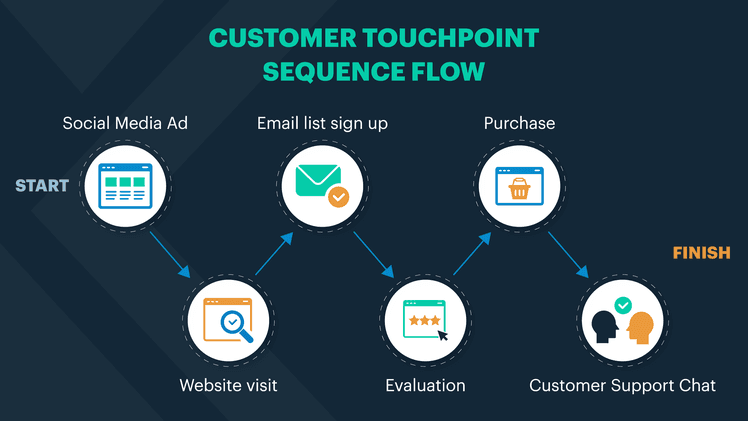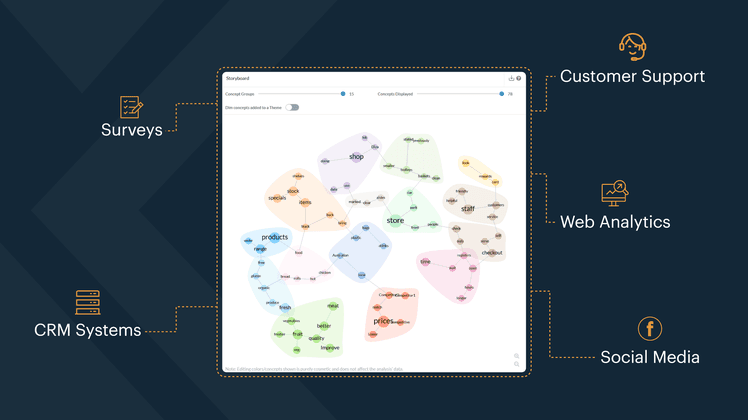Could better customer journey analytics really 10X your revenue?
Absolutely. In fact, companies that effectively leverage customer journey analytics have seen revenue increases lightyears ahead of previous levels.
By using a customer journey analytics platform to analyze customer interactions across multiple touchpoints, you can identify pain points, opportunities for improvement, and areas for growth. This leads to enhanced customer experiences, increased loyalty and retention, and ultimately, a significant boost in your bottom line.
In this comprehensive guide, we’ll walk you through the step-by-step process of creating a customer journey analytics approach that harnesses the power of customer behavior analysis to maximize your ROI.
Get ready to unlock insights that will transform your business and skyrocket your revenue.
What Is Customer Journey Analytics?
Customer journey analytics involves collecting and analyzing data from multiple touchpoints across the entire customer journey. A customer journey analytics solution links customer interactions and behavior data together efficiently. This includes interactions on websites, social media, email, customer service, and more. By integrating data from these various sources, businesses can gain a comprehensive view of how customers move through the buying stages and identify patterns and trends that can inform strategic decisions.
How Is Customer Journey Analytics Different Than Customer Journey Mapping?
While customer journey mapping is traditionally used by marketers to visualize the steps a customer takes from awareness to purchase, customer journey maps lay out the end-to-end journey in a clear way, documenting every touchpoint a customer experiences. Customer journey analytics takes this a step further by providing actionable insights based on real-time data. This allows businesses to:
Identify Pain Points: Pinpoint where customers are dropping off or experiencing issues.
Optimize Touchpoints: Improve interactions at critical stages of the journey.
Predict Behavior: Use historical data to forecast future customer actions.
Personalize Experiences: Tailor interactions based on individual customer preferences and behaviors.
A good practice is to have a customer journey map that works hand in hand with a customer journey analytics program. However you choose to map your customer journeys should be reflected in the data you also collect across every stage of the customer experience with your brand.

Benefits of Customer Journey Analytics
As a researcher, your primary goal is to use customer journey analytics to gain a deep understanding of your customers’ needs, behaviors, and preferences. Customer journey analytics is an essential tool that can help you achieve this objective by providing data-backed insights into how customers interact with your brand across various touchpoints.
Implementing customer journey analytics offers many benefits like:
Enhanced Customer Understanding: Gain a deeper understanding of customer needs, preferences, and behaviors.
Improved Customer Satisfaction: Identify and address pain points to enhance the overall customer experience.
Increased Revenue: Optimize the customer journey to drive conversions and increase sales.
Data-Driven Decision Making: Use real-time insights to make informed strategic decisions.
Competitive Advantage: Stay ahead of competitors by continuously improving the customer journey based on data-driven insights.
In the next section, we’ll explore in more detail some of the key ways that customer journey analytics offers invaluable insights to researchers, and how it can transform your business.
Data-Backed Understanding of Customer Behavior
Traditional research methods like surveys and focus groups can provide valuable insights, but they often fail to capture the complete picture of how customers behave. Customer journey analytics bridges this gap by offering a comprehensive view of how customers interact with a brand and engage along the various stages of their journey, from initial awareness to post-purchase interactions.
By analyzing data from multiple sources, including website analytics, social media, customer service interactions, and more, you can identify patterns and trends that would otherwise be difficult to detect. This data-driven approach allows you to move beyond assumptions and make informed decisions based on actual customer behavior.
Unlocking Business Value
Customer journey analytics not only helps researchers gain a deeper understanding of customer preferences but also unlocks significant business value. By identifying pain points, optimizing touchpoints, and predicting customer actions, you can directly impact key business metrics, such as customer satisfaction, retention, and revenue.
For example, by analyzing customer journey data, you may discover that a significant number of customers are abandoning their shopping carts due to a confusing checkout process. Armed with this insight, you can work with the relevant teams to streamline the checkout experience, potentially leading to increased conversions and revenue.
Predicting Customer Behavior and Improving Satisfaction
One of the most powerful aspects of customer journey analytics is its ability to predict customer actions throughout the customer's journey. By analyzing historical data and identifying patterns, you can anticipate future actions and proactively address potential issues before they arise.
For instance, if your data shows that customers who experience a certain issue are more likely to churn, you can implement targeted retention strategies to address that specific pain point. This proactive approach not only helps reduce customer churn but also improves overall customer satisfaction.
In the next section, we’ll explore some real-world use cases that demonstrate the transformative power of customer journey analytics and how it can drive tangible results across your organization.
Examples of Customer Journey Analytics In Action
Customer journey analytics can unlock significant value across businesses. By providing a data-driven understanding of customer interactions, it enables organizations to make informed decisions that enhance customer experiences and drive business growth.
Here are five real-world use cases that illustrate the transformative power of customer journey analytics:
Use Case 1: Identifying and Fixing Pain Points
Example: A retail company notices a high drop-off rate during the checkout process. By leveraging customer journey analytics, they identify that the majority of customers abandoned their carts at the payment stage, due to a complicated and lengthy checkout process.
Solution: The company streamlines the checkout process by simplifying the payment steps and offering multiple payment options. As a result, they see a significant reduction in cart abandonment rates and an increase in completed purchases.

Use Case 2: Enhancing Customer Engagement
Example: A subscription-based service wants to improve customer engagement and retention. By analyzing customer journey data, they discover that customers who engage with their educational content are more likely to renew their subscriptions.
Solution: The company implements a targeted content strategy, promoting educational resources to new and existing customers. This leads to higher engagement rates and improved customer retention.

Use Case 3: Optimizing Marketing Campaigns
Example: A B2B software company wants to optimize their marketing campaigns to increase lead generation. Customer journey analytics revealed that leads generated from webinars have a higher conversion rate compared to other channels.
Solution: The company focuses their marketing efforts on promoting webinars and creating more engaging content for these events. This strategy results in a higher number of qualified leads and improved conversion rates.
Use Case 4: Reducing Customer Churn
Example: A telecommunications company faces high customer churn rates. By analyzing customer journey data, they identify that customers who experience frequent service disruptions were more likely to switch to competitors.
Solution: The company implements proactive measures to address service disruptions, such as improving network infrastructure and offering compensation to affected customers. These efforts lead to a reduction in churn rates and increased customer loyalty.
Use Case 5: Improving Product Development
Example: A consumer electronics company wants to enhance their product development process. Customer journey analytics reveal that customers frequently mentioned specific features they wanted in product reviews and support interactions.
Solution: The company incorporates this feedback into their product development cycle, prioritizing the most requested features. This approach results in products that better met customer needs and received higher satisfaction ratings.
By leveraging customer journey analytics, businesses can gain actionable insights that drive improvements across various areas, from marketing and customer service to product development and beyond.
In the next section, we'll provide a step-by-step guide on how to set up customer journey analytics at your organization, ensuring you can harness its full potential.
How to Set Up Customer Journey Analytics at Your Organization
Implementing customer journey analytics in your organization involves several key steps. By following this guide, you can ensure a successful setup that provides valuable insights into your customers' behaviors and interactions.
Step 1: Define Your Customer Personas
Before diving into customer journey mapping, it's crucial to have a clear understanding of your target audience. Identifying key customer segments based on demographics, behavior, and preferences helps you create tailored experiences that resonate with each group.
To define your customer personas, start by analyzing your existing customer data. Look for patterns in age, gender, location, income level, and other relevant factors. Next, consider their behavior, such as purchasing habits, preferred channels, and engagement levels. Finally, delve into their preferences, including product or service interests, communication style, and pain points.
Once you have a comprehensive view of your customer segments, create detailed personas that represent each group. These personas will serve as a guide throughout the journey mapping process, ensuring that you're creating experiences that align with their needs and expectations.

Step 2: Map Out Customer Touchpoints
With your customer personas in hand, it's time to map out all potential customer interactions across various channels. This includes your website, social media profiles, email campaigns, customer support, and any other touchpoints where customers engage with your brand.
Organize these touchpoints in a logical sequence based on typical customer behavior. This may look like a more traditional customer journey map at first. For example, a customer might first discover your brand through a social media ad, then visit your website to learn more, and finally make a purchase after receiving a targeted email campaign.
Example of a Customer Touchpoint Sequence
Social media ad exposure
Website visit and product exploration
Email campaign with personalized offers
Product purchase
Post-purchase customer support interaction
By visualizing the customer journey as a series of touchpoints, you can better understand how customers interact with your brand and identify areas for improvement.

Step 3: Collect and Integrate Data
To create an accurate and comprehensive customer journey map, you need to gather data from various sources. This includes web analytics, customer relationship management (CRM) systems, surveys, and any other platforms where customer data is collected.
Ensure that the data is consistent and accurate across all platforms. This may require data cleaning and standardization to eliminate discrepancies and ensure a reliable foundation for analysis.
Once your data is integrated, you can begin to identify patterns and trends in customer actions. This will help you understand how customers move through the journey, where they encounter friction, and what factors influence their decisions.

Step 4: Analyze and Visualize Customer Journeys
With your data collected and integrated, it's time to use analytics tools to identify patterns, trends, and correlations in customer sentiment and behavior. This process will help you uncover valuable insights into how customers navigate their journey and where opportunities for improvement lie.
To make these insights more accessible and actionable, create visual representations of customer journeys. This can include flowcharts that illustrate the path customers take from awareness to purchase, heatmaps that highlight areas of high engagement or drop-off, and other visual aids that make complex data easier to understand.
By visualizing customer journeys, you can quickly identify areas where customers experience friction or frustration, as well as opportunities for optimization and revenue growth.
Step 5: Identify Pain Points and Opportunities
As you analyze and visualize customer journeys, pay close attention to areas where customers encounter obstacles or disengagement. These pain points can include confusing navigation, lengthy checkout processes, or lack of personalized communication.
For each pain point identified, consider the potential impact on customer experience and revenue. Prioritize addressing the most significant issues first, as these will likely have the greatest effect on customer satisfaction and retention.
In addition to pain points, look for opportunities to enhance the customer journey. This could involve introducing new features, streamlining processes, or creating more targeted and personalized experiences.
Here are some common pain points to look out for, in mapping your customer touchpoints, analytics, and opportunities for improvement:
Pain Point | Description | Opportunity for Improvement |
|---|---|---|
Confusing Navigation | Customers struggle to find information or products due to poor website structure. | Simplify website layout, improve search functionality, and ensure clear categorization of products and information. |
Lengthy Checkout Process | Customers abandon carts due to a complicated and time-consuming checkout process. | Streamline the checkout process by reducing steps, offering guest checkout, and integrating multiple payment options. |
Lack of Personalized Communication | Customers feel disconnected due to generic and irrelevant communications. | Implement personalized marketing strategies using customer data to tailor messages and offers to individual preferences. |
Slow Page Load Times | Customers leave the site due to slow loading pages. | Optimize website performance by compressing images, leveraging caching, and using a content delivery network (CDN). |
Limited Payment Options | Customers are unable to complete purchases due to restricted payment methods. | Expand payment options to include popular methods like e-wallets, QR codes, and international payment gateways. |
Step 6: Implement Changes and Test
With pain points and opportunities identified, it's time to make data-driven changes to optimize customer journeys. Start by developing a plan that outlines the specific changes you want to make, the resources required, and the expected impact on key metrics.
As you implement these changes, be sure to conduct A/B testing to validate their effectiveness. This involves creating two versions of a touchpoint or experience, with one version incorporating the change and the other serving as a control. By comparing the performance of the two versions, you can determine whether the change had the desired effect and iterate accordingly.
Remember to test one change at a time to isolate the impact of each optimization. This will help you make more informed decisions and avoid confounding variables that could skew your results.
Step 7: Monitor and Iterate
Creating an optimized customer journey is not a one-time event, but rather an ongoing process of monitoring, analysis, and refinement. Continuously track key metrics, such as conversion rates, customer lifetime value, and churn, to gauge the effectiveness of your optimizations.
Regularly update and refine your journey maps based on new insights and changing customer preferences and needs. As your business evolves and new technologies emerge, your customer journeys will likely need to adapt to stay relevant and effective.
Example of Key Metrics to Monitor
Conversion rates at each stage of the journey
Customer lifetime value
Churn rate
Net Promoter Score (NPS)
Customer satisfaction scores
By committing to continuous improvement and data-driven decision-making, you can create customer journeys that not only meet but exceed expectations, driving revenue growth and long-term success.
Harnessing the Power of Customer Behavior Analysis
TL;DR:
Quantitative and qualitative data provide a comprehensive view of the customer journey
Analyzing customer patterns data uncovers opportunities for improvement and growth
Combining multiple data sources leads to actionable insights and better decision-making
Customer behavior analysis is a critical component of customer journey analytics. By examining both quantitative and qualitative data in your customer journey analytics program, you can gain a deeper understanding of how customers interact with your products, services. Here's how you'll want to think about leveraging both.
Quantitative Data: Measuring the Customer Journey
Quantitative data provides a foundation for understanding customer behavior through measurable metrics. This data can be collected from various sources, including:
Web Analytics
Web analytics tools like Google Analytics track key metrics such as page views, sessions, and bounce rates. These insights help businesses understand how customers navigate their website, which pages are most popular, and where visitors may be dropping off. By identifying pain points and areas for improvement, companies can optimize their website to provide a better user experience and encourage desired actions, such as making a purchase or filling out a contact form.
Transactional Data
Transactional data, including purchase history and average order value, provides valuable insights into customer spending habits and preferences. By analyzing this data, businesses can identify their most profitable customer segments, popular product categories, and cross-selling or upselling opportunities. This information can be used to personalize marketing campaigns, tailor product recommendations, and develop targeted promotions that drive revenue growth.
Behavioral Data
Behavioral data encompasses how customers interact with a company's products or services, such as feature usage and time spent on site. This information helps businesses understand which features are most valuable to customers and how engaged users are with their offerings. By identifying patterns in customer actions, companies can prioritize product development efforts, improve onboarding processes, and create more engaging experiences that keep customers coming back.
Qualitative Data: Understanding the "Why" Behind Customer Actions
While quantitative data provides a solid foundation for understanding customer actions, qualitative data offers deeper insights into the motivations, emotions, and opinions driving those actions. This data can be gathered through various methods, including:
Customer Feedback
Customer feedback, obtained through surveys, reviews, and support tickets, provides valuable insights into the customer experience. By actively listening to customer opinions and concerns, businesses can identify areas for improvement, address pain points, and demonstrate their commitment to customer satisfaction. This feedback can also be used to inform product development, marketing strategies, and customer service initiatives.
User Testing
User testing, such as usability studies and focus groups, allows businesses to observe how customers interact with their products or services in real-time. This qualitative data helps companies identify usability issues, gather feedback on new features or designs, and gain a deeper understanding of customer needs and preferences. By incorporating user testing insights into the product development process, businesses can create more intuitive, user-friendly experiences that drive customer satisfaction and loyalty.
Online Reviews Sentiment
Online review sites provide a wealth of qualitative data through comments and dialogue on brand experiences. By monitoring sites like Product Review AU, or G2, businesses can gauge customer opinions, identify emerging trends, and respond to feedback in real-time. This data can also be used to inform content marketing strategies, and update product roadmap plans with features that resonate with feedback.
Overcoming Challenges in Customer Journey Analytics
Data Silos and Integration Issues
One of the biggest challenges in customer journey analytics is dealing with data silos and integration issues. Customer data often resides in disparate systems, making it difficult to gain a holistic view of the customer journey. Siloed data can lead to incomplete insights, inconsistent experiences, and missed opportunities for optimization.
To overcome data silos, companies need to invest in data integration solutions that can consolidate data from various sources into a centralized repository.
Additionally, adopting a data governance framework is crucial for ensuring data quality, consistency, and security across the organization. Establishing clear data ownership, data standards, and data access policies can help mitigate integration issues and ensure the reliability of customer journey analytics.
Privacy Concerns and Regulatory Compliance
With the increasing focus on data privacy and the introduction of regulations like the General Data Protection Regulation (GDPR) and the California Consumer Privacy Act (CCPA), companies face the challenge of balancing personalization efforts with privacy compliance.
According to a 2023 survey by Cisco, 84% of consumers care about data privacy and want more control over their data. Additionally, non-compliance with privacy regulations can result in hefty fines, with GDPR penalties reaching up to 4% of a company's global annual revenue.
To address privacy concerns and ensure regulatory compliance, businesses need to adopt privacy-by-design principles and implement strong data protection measures. This includes obtaining explicit consent for data collection, providing transparency about data usage, and enabling customers to exercise their data rights.
Investing in privacy management solutions like OneTrust, TrustArc, and Privitar can help automate privacy compliance processes and ensure adherence to regulatory requirements while enabling personalized customer experiences.
Organizational Resistance to Change
Implementing customer journey analytics often requires significant organizational changes, including breaking down silos, fostering cross-functional collaboration, and adopting new technologies and processes. However, resistance to change can be a major hurdle in realizing the full potential of customer journey analytics.
According to a 2023 study by McKinsey, 70% of digital transformation initiatives fail, largely due to organizational resistance and lack of employee engagement. Overcoming resistance to change requires strong leadership, clear communication, and employee training and support.
To drive organizational buy-in for customer journey analytics, it is essential to:
Communicate the benefits and value of customer journey analytics to all stakeholders
Involve employees in the process and seek their input and feedback
Provide training and support to help employees adapt to new technologies and processes
Celebrate quick wins and share success stories to build momentum and enthusiasm
Companies that successfully overcome organizational resistance and embrace customer journey analytics are well-positioned to gain a competitive edge and drive long-term growth.
The Future of Customer Journey Analytics: Emerging Trends and Technologies
In addition to these core steps, you'll want to keep an eye on how the market is evolving, and make adjustments to your program accordingly. Here are some of the key themes that should be shaping how you set up your tools, and where you source your data.
AI-Powered Predictive Analytics
Artificial intelligence (AI) is revolutionizing customer journey analytics by enabling businesses to predict customer actions and preferences. By leveraging machine learning algorithms, companies can analyze vast amounts of data from various touch points to identify patterns and anticipate customer needs. This allows for proactive engagement and personalized experiences that drive customer satisfaction and loyalty.
Real-Time Personalization and Optimization
Real-time personalization is becoming increasingly crucial in delivering exceptional customer experiences. By leveraging customer data and advanced analytics, businesses can tailor content, offers, and interactions to individual preferences in real-time. This level of personalization not only improves customer engagement but also drives higher conversion rates and customer lifetime value.
A 2023 study by Epsilon found that 80% of consumers are more likely to make a purchase when brands offer personalized experiences. Additionally, personalization can lift sales by 10% or more, according to a report by Boston Consulting Group.
To achieve real-time personalization, companies need to invest in customer data platforms (CDPs) that unify data from various sources and enable real-time segmentation and targeting.
Omnichannel Journey Orchestration
As customers interact with brands across multiple channels and devices, providing a seamless and consistent experience becomes paramount. Omnichannel journey orchestration involves coordinating customer interactions across various touch points to create a unified and cohesive experience.
According to a 2024 report by Forrester, companies with strong omnichannel customer engagement strategies retain on average 89% of their customers, compared to 33% for companies with weak strategies. This underscores the importance of orchestrating journeys across channels to foster customer loyalty and retention.
To excel in omnichannel journey orchestration, businesses need to leverage journey mapping tools and customer engagement platforms that enable cross-channel coordination and real-time interaction management.
Ready to Set Up Your Customer Journey Analytics?
Kapiche is a trusted provider of customer journey analytics tools, offering powerful features that help you gain a deeper understanding of your customers' behaviors and interactions. With Kapiche, you can track and analyze data across multiple touchpoints, identify pain points, and optimize the customer journey to drive business growth.
With Kapiche you can:
Leverage real-time analytics and automated reporting
Achieve seamless integration with your existing tech stack
Get actionable insights to improve customer satisfaction and reduce churn
Ready to see how Kapiche can transform your customer journey analytics?
Head over to the Kapiche demo page to watch a live on-demand demo of the platform. If you have any questions, don't hesitate to reach out. We're here to help you take your data collection and analysis to the next level.







